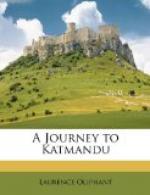In the colder months they wear home-spun woollen clothes. The dress of the women differs little from that of the men, except that the coat is longer, resembling a dressing-gown, and a sort of bodice is generally worn beneath it; a white shawl wrapped round the waist completes one of the most ungraceful costumes imaginable. All the men and some of the women are armed with the kukri, a heavy-bladed weapon or knife of singular shape. But lest this be too unprepossessing a picture of the Newars, or aborigines of Nepaul (for the Ghorkas are a superior and very different race), I should remark that I had no opportunity of seeing any of the females of the higher orders of either nation. The Ghorkas, being, for the most part, bigoted Hindoos, are prevented by their religion from allowing the women to appear in public. The Newars, not fettered by any such restraint, can now boast very few noble families; the ancient grandees of the Newar dynasty are extirpated, with the exception of one or two of the old aristocracy, who are in the last stage of decay. I cannot agree with Colonel Kirkpatrick (who wrote an account of his visit to Nepaul in 1803) in thinking that, “though the Newars have round and rather flat faces, small eyes, and low spreading noses, they bear no resemblance to Chinese features;” on the contrary, I was much struck with the great similarity of the mass of the lower orders to the Chinese. Their imperturbable good humour and unaffected simplicity as plainly proved them a hill race, as did their picturesque dwellings and sturdy limbs. Altogether this class of the inhabitants of Nepaul are a cheerful, happy race, for whom one could feel a sort of affection after becoming reconciled to their appearance; but a woman is certainly not fascinating when what ought to be nose is nothing but cheek with two holes in it, and what ought to be neck is almost body as well. If people have protuberances in wrong places, it of course requires a little time for the eye to become accustomed to them. It may be that a goitre is a beauty in the eyes of many a young Nepaulese swain. It matters little, however, to a young Newar bride whether her husband admires her or not, for she is at liberty to claim a divorce whenever she pleases, and, if her second choice be not of lower caste than herself, she may leave him at pleasure and return to her original spouse, resuming the charge of any family she may have had by him.
The Ghorkas are the conquerors of Nepaul, and now compose the army; they have grants of land called jaghires, on which they live when not actually on service. They are a handsome and independent race, priding themselves upon not being able to do anything but fight; and in their free and sometimes noble carriage often reminded me of the Tyrolese.
Besides the Ghorkas and Newars there are two or three other tribes, each consisting of but a limited number, and possessing no peculiar distinguishing marks, except the differences to be found in their religious opinions, which are generally a mixture of the Bhuddist and Hindoo creeds.




